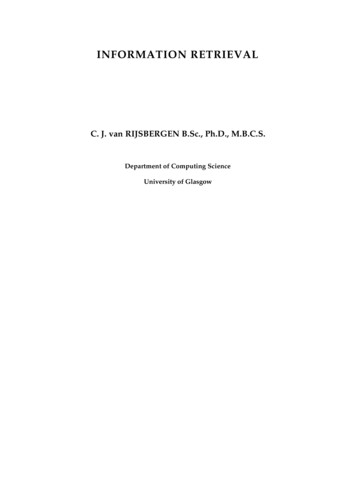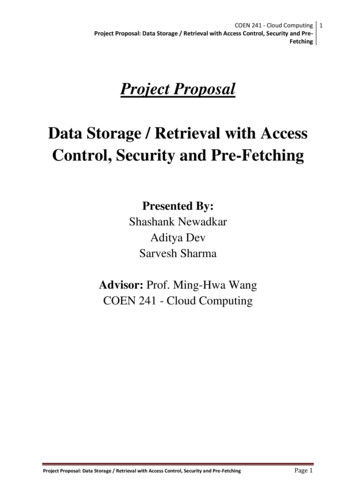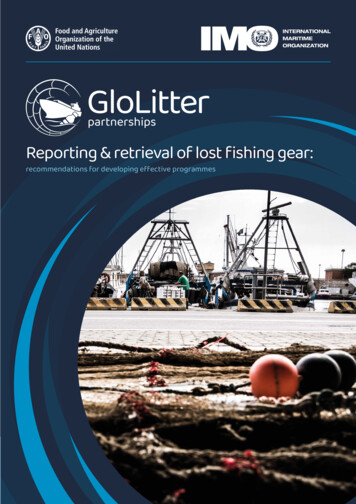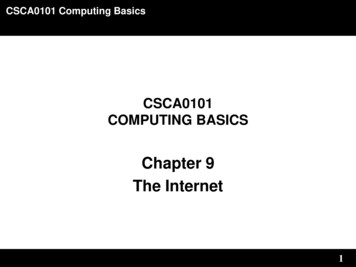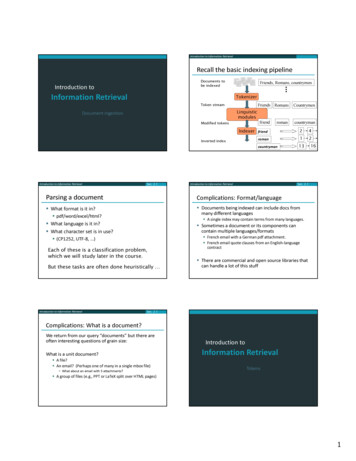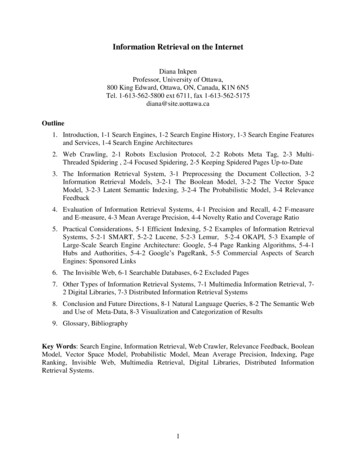
Transcription
Information Retrieval on the InternetDiana InkpenProfessor, University of Ottawa,800 King Edward, Ottawa, ON, Canada, K1N 6N5Tel. 1-613-562-5800 ext 6711, fax 1-613-562-5175diana@site.uottawa.caOutline1. Introduction, 1-1 Search Engines, 1-2 Search Engine History, 1-3 Search Engine Featuresand Services, 1-4 Search Engine Architectures2. Web Crawling, 2-1 Robots Exclusion Protocol, 2-2 Robots Meta Tag, 2-3 MultiThreaded Spidering , 2-4 Focused Spidering, 2-5 Keeping Spidered Pages Up-to-Date3. The Information Retrieval System, 3-1 Preprocessing the Document Collection, 3-2Information Retrieval Models, 3-2-1 The Boolean Model, 3-2-2 The Vector SpaceModel, 3-2-3 Latent Semantic Indexing, 3-2-4 The Probabilistic Model, 3-4 RelevanceFeedback4. Evaluation of Information Retrieval Systems, 4-1 Precision and Recall, 4-2 F-measureand E-measure, 4-3 Mean Average Precision, 4-4 Novelty Ratio and Coverage Ratio5. Practical Considerations, 5-1 Efficient Indexing, 5-2 Examples of Information RetrievalSystems, 5-2-1 SMART, 5-2-2 Lucene, 5-2-3 Lemur, 5-2-4 OKAPI, 5-3 Example ofLarge-Scale Search Engine Architecture: Google, 5-4 Page Ranking Algorithms, 5-4-1Hubs and Authorities, 5-4-2 Google’s PageRank, 5-5 Commercial Aspects of SearchEngines: Sponsored Links6. The Invisible Web, 6-1 Searchable Databases, 6-2 Excluded Pages7. Other Types of Information Retrieval Systems, 7-1 Multimedia Information Retrieval, 72 Digital Libraries, 7-3 Distributed Information Retrieval Systems8. Conclusion and Future Directions, 8-1 Natural Language Queries, 8-2 The Semantic Weband Use of Meta-Data, 8-3 Visualization and Categorization of Results9. Glossary, BibliographyKey Words: Search Engine, Information Retrieval, Web Crawler, Relevance Feedback, BooleanModel, Vector Space Model, Probabilistic Model, Mean Average Precision, Indexing, PageRanking, Invisible Web, Multimedia Retrieval, Digital Libraries, Distributed InformationRetrieval Systems.1
AbstractThe main components of a search engine are the Web crawler which has the task of collectingwebpages and the Information Retrieval system which has the task of retrieving text documentsthat answer a user query. In this chapter we present approached to Web crawling, InformationRetrieval models, and methods used to evaluate the retrieval performance. Practicalconsiderations include information about existing IR systems and a detailed example of a largescale search engine (Google), including the idea of ranking webpages by their importance (theHubs an Authorities algorithm, and Google’s PageRank algorithm). Then we discuss theInvisible Web, the part of the Web that is not indexed by search engines. We briefly presentother types of IR systems: digital libraries, multimedia retrieval systems (music, video, etc.), anddistributed IR systems. We conclude with a discussion of the Semantic Web and future trends invisualizing search results and inputting queries in natural language.INTRODUCTIONThere is a huge quantity of text, audio, video, and other documents available on theInternet, on about any subject. Users need to be able to find relevant information to satisfy theirparticular information needs. There are two ways of searching for information: to use a searchengines or to browse directories organized by categories (such as Yahoo Directories). There isstill a large part of the Internet that is not accessible (for example private databases and intranets).Information retrieval (IR) is the task of representing, storing, organizing, and offeringaccess to information items. IR is different from data retrieval, which is about finding precisedata in databases with a given structure. In IR systems, the information is not structured, it iscontained in free form in text (webpages or other documents) or in multimedia content. The firstIR systems implemented in 1970’s were designed to work with small collections of text (forexample legal documents). Some of these techniques are now used in search engines.In this chapter we describe information retrieval techniques, focusing on the challengesfaced by search engines. One particular challenge is the large scale, given by the huge number ofwebpages available on the Internet (for example, about 8 billion webpages were indexed byGoogle in 2005). Another challenge is inherent to any information retrieval system that dealswith text: the ambiguity of the natural language (English or other languages) that makes itdifficult to have perfect matches between documents and user queries.The organization of this chapter is as follows. We briefly mention the search engineshistory, features, and services. We present the generic architecture of a search engine. Wediscuss its Web crawling component, which has the task to collect webpages to be indexed. Thenwe focus on the Information Retrieval component which has the task of retrieving documents(mainly text documents) that answer a user query. We present current methods used to evaluatethe performance of the Information Retrieval component. Practical considerations includeinformation about existing IR systems and a detailed example of a large-scale search engine(Google); we present methods for ranking webpages by their importance (the Hubs anAuthorities algorithm and Google’s PageRank algorithm). In another section, we discuss theInvisible Web, the part of the Web that is not indexed by search engines. We briefly presentother types of IR systems: digital libraries, multimedia IR systems, and distributed IR systems.We conclude with a discussion of the Semantic Web and other future trends.2
Search enginesThere are many general-purpose search engines available on the Web. A resource containing upto-date information on the most used search engines is: http://www.searchenginewatch.com.Here are some popular search engines (in alphabetic order):AllTheWeb http://www.alltheweb.com/AltaVista http://www.altavista.com/Excite http://www.excite.com/Google http://www.google.com/Hotbot http://www.hotbot.com/Lycos http://www.lycos.com/MSN Search http://search.msn.com/Teoma http://teoma.com/WiseNut http://www.wisenut.com/Yahoo! http://search.yahoo.com/Meta-search engines combine several existing search engines in order to providedocuments relevant to a user query. Their task is reduced to ranking results from the differentsearch engines and eliminating duplicates. Some examples are: http://www.metacrawler.com/,http://www.mamma.com/, and http://www.dogpile.com/.Search Engine HistoryThe very first tool used for searching on the Internet was called Archie (the name stands for"archive"). It was created in 1990 by Alan Emtage, a student at McGill University in Montreal.The program downloaded the directory listings of all the files located on public anonymous FTPsites, creating a searchable database of filenames. Gopher was created in 1991 by Mark McCahillat the University of Minnesota. While Archie indexed file names, Gopher indexed plain textdocuments. Two other programs, Veronica and Jughead, searched the files stored in Gopherindex systems.The first Web search engine used Wandex, a now-defunct index collected by the WorldWide Web Wanderer, a web crawler developed by Matthew Gray at MIT in 1993. Another veryearly search engine, Aliweb, also appeared in 1993, and still runs today. The first "full text"crawler-based search engine was WebCrawler, 1994. Unlike its predecessors, it let users searchfor any word in any web page; this became the standard for all major search engines ever since.It was also the first one to be widely known to the public. Also in 1994, Lycos (which started atCarnegie Mellon University) came out, and became a major commercial endeavor.Soon after, many search engines appeared and became popular. These included Excite,Infoseek, Inktomi, Northern Light, and AltaVista. In some ways, they competed with populardirectories such as Yahoo!. Later, the directories integrated or added on search enginetechnology for greater functionality.Search engines were also known for the Internet investing frenzy that occurred in the late1990s. Several companies entered the market spectacularly, with record gains during their initialpublic offerings. Some have taken down their public search engine, and are marketing enterpriseonly editions, such as Northern Light.Around 2001, the Google search engine rose to prominence (Page and Brin, 1998). Itssuccess was based in part on the concept of link popularity and PageRank, that uses the premisethat good or desirable pages are pointed to by more pages than others. Google's minimalist user3
interface was very popular with users, and has since spawned a number of imitators. Google iscurrently the most popular search engine. In 2005, it indexed approximately 8 billion pages,more than any other search engine. It also offers a growing range of Web services, such asGoogle Maps and online automatic translation tools.In 2002, Yahoo! acquired Inktomi and in 2003, Yahoo! acquired Overture, which ownedAlltheWeb and AltaVista. Despite owning its own search engine, Yahoo initially kept usingGoogle to provide its users with search results. In 2004, Yahoo! launched its own search enginebased on the combined technologies of its acquisitions and providing a service that gave preeminence to the Web search engine over its manually-maintained subject directory.MSN Search is a search engine owned by Microsoft, which previously relied on othersfor its search engine listings. In early 2005 it started showing its own results, collected by its owncrawler. Many other search engines tend to be portals that merely show the results from anothercompany's search engine. For more details and search engine timelines see, for example,http://en.wikipedia.org/wiki/Search engine.Search Engine Features and ServicesSearch engines allow a user to input keywords that describe an information need. The also offeradvanced search capabilities. Although they lead to more precise, they are less utilized by users.We briefly discuss some advanced search features. Boolean features (AND, OR, NOT) thatallow retrieval of documents that contain all the keywords (AND), any of the keywords (OR),exclude some words (NOT), or combinations of these Boolean operators. The proximity featuresearches for phrases or consecutive words (usually simple search can do this if the words aresurrounded by double quotes). The search can be done only in particular fields, such as URLs ortitles. Limits can be imposed on the type of retrieved pages: date, language, file types, etc.Some search engines also offer services: news directories, image search, maps (such asGoogle Maps), language tools (such as automatic translation tools or interfaces in particularlanguages), newsgroup search, and other specialized searches.Search Engine ArchitecturesThe components of a search engine are: Web crawling (gathering webpages), indexing(representing and storing the information), retrieval (being able to retrieve documents relevant touser queries), and ranking the results in their order of relevance. Figure 1 presents a simplifiedview of the components of a search engine. More details about the main module, the IR system,will follow in the next sections.4
WebDocumentCorpusSpiderIRSystemInput:Query StringOutput:1. Page 12. Page 23. Page 3.RankedDocumentsFigure 1. The simplified architecture of a search engine.WEB CRAWLINGWeb crawlers, also known as spiders or robots, have the task to collect webpages to build thetext collection for the IR system. The text is extracted from the HTML code of the webpages.Some information related to the HTML format may be stored too. For example, text in headingsor in bold font can be given higher weight than the rest of the text.A crawler starts with one or more http addresses (a set of root URLs), and follows all thelinks on these pages recursively, to find additional pages. It can proceed by depth-first searching(follow the first link in a page and all the links in the new pages that it leads to, then come backto follow the rest of the links in the current page) or by breadth-first searching (follow all thelinks in the page for one step, then the links in the pages they point to, for one step, etc.).Breadth-first has the advantage that it explores uniformly outward from the root page butrequires memory to store all the links waiting to be traversed on the previous level (exponentialin the depth of the links structure). It is the standard spidering method. Depth-first requires lessmemory (linear in depth) but it might get “lost” pursuing a single thread. Both strategies can beeasily implemented using a queue of links (URLs) to be visited next. How new links are added tothe queue determines the search strategy. FIFO (first in first out, append to end of the queue)gives breadth-first search. LIFO (last in first out, add to front of queue) gives depth-first search.Heuristically ordering the queue gives a “focused crawler” that directs its search towards“interesting” pages. A spider needs to avoid visiting the same pages again when the links arecircular; it needs to keep track of pages that were already visited.To extract links from a webpage in order to collect candidate links to follow, HTMLhyperlink fields are parsed. Here are two examples of hyperlinks: a href “http://www.site.uottawa.ca/ diana/csi4107” frame src “site-index.html” 5
If the URL is not specified, like in the last example, the link is relative to the current base URL.If a file name is not specified, a default name is used (such as index.hml). The links are put intocanonical form: the ending slash is removed, if there is one; internal references within the samepage are removed, etc. Once the pages are collected, the text is extracted from the HTMLdocuments, to be processed by the IR system.Robot exclusion protocols are used to prevent certain sites or webpages from beingindexed by Web crawlers. Web sites and pages can specify that robots should not crawl or indexcertain areas, by using the Robots Exclusion Protocol or the robots meta tag. The second one isnewer and less well-adopted than the first one. These standards are conventions to be followedby “good robots”. They cannot be enforced, but companies have been prosecuted for“disobeying” these conventions and “trespassing” on private cyberspace.The Robots Exclusion ProtocolThe Robots Exclusion Protocol is a site-wide specification of excluded directories. The siteadministrator has to put a “robots.txt” file at the root of the host’s Web directory. See forexample http://www.ebay.com/robots.txt. The file “robots.txt” is a list of excluded directories fora given robot (user-agent). This file contains blank lines to separate different user-agentdisallowed directories, with one directory per “Disallow” line. No regular expression can be usedas patterns for directories.To exclude all robots from the entire site, the file would contain:User-agent: *Disallow: /To exclude specific directories:User-agent: *Disallow: /tmp/Disallow: /cgi-bin/Disallow: /users/paranoid/To exclude a specific robot:User-agent: GoogleBotDisallow: /To allow a specific robot:User-agent: GoogleBotDisallow:The Robots Meta TagAn individual document tag can be used to exclude indexing or following links in a particularwebpage. The HEAD section of a specific HTML document can include a robots meta tag, suchas meta name “robots” content “none” . The content value can be a pair of values fortwo aspects: index or noindex for allowing or disallowing the indexing of this page, andfollow or nofollow for allowing or disallowing following the links in this page. There are twospecial values: all index,follow and none noindex,nofollow. Examples: meta name “robots” content “noindex,follow” meta name “robots” content “index,nofollow” meta name “robots” content “none” 6
Multi-Threaded SpideringNetwork delays are frequent when downloading individual pages. It is best to have multiplethreads running in parallel, each requesting a page from a different host. The URL’s can bedistributed to threads, to guarantee equitable distribution of requests across different hosts, inorder to maximize through-put and avoid overloading any single server. For example, earlyGoogle spiders had multiple coordinated crawlers with about 300 threads each, together beingable to download over 100 pages per second.Focused SpideringMore “interesting” pages could be explored first. There are two styles of focus: topic-directedand link-directed. For the former, if the desired topic description or sample pages of interest aregiven, the spidering algorithm could sort the queue of links by the similarity (e.g. cosine metric)of their source pages and/or anchor text to this topic description. For the latter, the spider couldkeep track of in-degree and out-degree of each encountered page, and sort the queue to preferpopular pages with many in-coming links (authorities), or to prefer summary pages with manyout-going links (hubs). See the section on page ranking algorithms for more details.Keeping Spidered Pages Up-to-DateThe Web is very dynamic: there are many new pages, updated pages, deleted pages, etc. Asearch engine needs to periodically check spidered pages for updates and deletions. A spidercould look in the HTML head information (e.g. meta tags on the last update) to determine if thepage has changed, and only reload the entire the page if needed. It could track how often eachpage is updated and preferentially return to pages which are historically more dynamic. It couldpreferentially update pages that are accessed more often to optimize the freshness of popularpages.THE INFORMATION RETRIEVAL SYSTEMFigure 2 presents a more detailed view of the architecture of an IR system (Baeza-Yates andBerthier Ribeiro-Neto, 1999). Text Operations are used to preprocess the documents collectionsand to extract index words. The indexing module constructs an inverted index from words todocument pointers. The searching module retrieves documents that contain given query words,using the inverted index. The ranking module scores all the retrieved documents according to arelevance metric. The user interface manages interaction with the user: the input of the query andthe output of the ranked documents, including the visualization of results. The query operationscan transform the query in order to improve retrieval (query expansion using synonyms from athesaurus, query transformation using relevance feedback).7
User xt OperationsLogical Figure 2. The architecture of an IR system: Text operations are applied of the text of thedocuments and on the description of the user information need in order to transform them in asimplified form needed for computation. The documents are indexed and the index is used toexecute the search. After ranked documents are retrieved, the user can provide feedback whichcan be used to refine the query and restart the search for improved results.Preprocessing the document collectionThere are several preprocessing steps needed to prepare the document collection for the IR task.The first step is to filter out unwanted characters and markup (e.g. HTML tags, punctuation,numbers, etc.). Then the text needs to be broken into tokens (keywords) by using as delimiterswhite space and punctuation characters. This it not quite as straightforward as it seems, sincewords in texts are not always clearly delimited (for example, if the text is You can’t do this, youcan consider the apostrophe as a word separator to get two words can and t, or ignore it asseparator and consider one word can’t, or expand the contacted form into two words can and notand use the white space as separator).The keywords can be used as they are, or they can be transformed into a base form, forexample nouns in the singular form, verbs in the infinitive form, etc. (e.g., books becomes book,talked becomes talk). A common approach is to stem the tokens to “stem” forms. For example,computational becomes comput and computing becomes comput. Stemming the terms beforebuilding the inverted index has the advantage that it reduces the size of the index, and allows forretrieval of webpages with various inflected forms of a word (for example, when searching forwebpages with the word computation, the results will include webpages with computations andcomputing). Stemming is easier to do than computing base forms, because stemmers removesuffixes, without needing a full dictionary of words in a language. A popular and fast stemmer isPorter’s stemmer.Another useful preprocessing step is to remove very frequent words that appear in mostof the documents and do not bear any meaningful content. They are called stopwords (e.g., a,the, it, of, could, etc.). An example of stopwords list can be found tml.8
Important phrases composed of two or more words could also be detected to be used askeywords (possibly using a domain specific dictionary, or using a statistical method foranalyzing the text collection in order to detect sequences of words that appear together veryoften).Now the text is ready for the next step, building the inverted index that stores for eachkeyword a list of documents that contain it, in order to allow for fast access during the retrievalstep.Information Retrieval ModelsThis section presents information retrieval models that can be applied on any text collection. Notall the IR models are easily scaled up to be able to deal with a very large collection, such aspages collected from the Web. The most important IR models are: the Boolean Model, theVector Space Model, and the Probabilistic Model. Various extensions of these models arepossible. We discuss one of them here, Latent Semantic Indexing, which is an extension of theVector Space Model.The Boolean ModelThe Boolean model is the simplest to implement. A document is represented as a set of keywords.Queries are Boolean expressions of keywords, connected by AND, OR, and NOT, including theuse of brackets to indicate the scope of these operators. For example, the query “all the hotels inRio Brazil or Hilo Hawaii, but not Hilton” is typed by the user as:[[Rio & Brazil] [Hilo & Hawaii]] & hotel & !Hilton]The output of the system is a list of documents that are relevant, but there will be no partialmatches or ranking. The Boolean model is very rigid: AND means “all”; OR means “any”. Allmatched documents will be returned, making it difficult to control the number of documentsretrieved. All the matched documents satisfy the query to the same degree; that makes it difficultto rank the output. Another disadvantage of this model is that is it not easy for the users toexpress complex queries.The Vector Space ModelThe vector space model of information retrieval is a very successful statistical method proposedby Salton (1989). It generates weighted term vectors for each document in the collection, and forthe user query. Then the retrieval is based on the similarity between the query vector anddocument vectors. The output documents are ranked according to this similarity. The similarityis based on the occurrence frequencies of the keywords in the query and in the documents.Let’s assume that t distinct terms remain after preprocessing; let’s call them index termsor the vocabulary. These terms form a vector space with dimensionality t, the size of thevocabulary. Each term i, in a document j, is given a weight wij. Both the documents and thequeries are expressed as t-dimensional vectors: dj (w1j, w2j, , wtj).A collection of N documents can be represented in the vector space model by adocuments-by-terms matrix. An entry in the matrix corresponds to the “weight” of a term in thedocument; zero means the term has no significance in the document; it simply doesn’t appear inthe document. The matrix tends to contain lots of zeros.9
T1 T2 .d1 w11 w21 d2 w12 w22 ::::::dN w1N w2N Ttwt1wt2::wtNThe weights in the matrix can be 1 if the term occurs in the document and 0 if it does not(binary weights); but the more frequent terms in a document are more important, i.e., moreindicative of the topic. Therefore it is good to use the frequencies of the terms as weights.Let fij be the frequency of the term Ti in the document djWe can normalize the term frequency (tf) across the entire corpus: tfij fij / max{fij}.Terms that appear in many different documents are less indicative of overall topic.Let dfi be the document frequency of term Ti – the number of documents containing the term i,and let idfi be the inverse document frequency of term Ti:idfi log (N/dfi)(where N is the total number of documents). The idf value is an indication of a term’sdiscrimination power. The logarithm is used to dampen the effect relative to tf. A typicalcombined term importance indicator is tf-idf weighting:wij tfij· idfi tfij log (N/dfi).A term occurring frequently in the document but rarely in the rest of the collection isgiven high weight. Many other ways of determining term weights have been proposed.Experimentally, tf-idf has been found to work well.The query is also transformed into a vector. It is typically treated as a document and alsotf-idf weighted. Alternatively, the user could supply weights for the given query terms.The similarity between vectors for the document dj and the query q can be computed asthe vector inner product:t sim( d ,q ) d q w wijiqjji 1where wij is the weight of term i in document j and wiq is the weight of term i in the queryFor binary vectors, the inner product is the number of matched query terms in thedocument (the size of the intersection). For weighted term vectors, it is the sum of the productsof the weights of the matched terms. There are several problems with the inner product: it doesnot have a bounded range of values; it favors long documents with a large number of uniqueterms; it measures how many terms are matched but not how many terms are not matched.The cosine similarity measure tends to work better. The formula is the same as the innerproduct, but it is normalized by the length of the documents and the length of the query (thelength of a vector is the square root of the sum of the squares of its components). dj qcosSim( d ,q ) jdj qt ( w ij w iq )i 1t2 t2 w ij w iqi 1i 110
The cosine measures the angles between the two vectors (the higher the cosine value –closer to 1, the smaller the angle between the vector of the document and the vector of the query,therefore a more relevant document). Because we consider only the angle, the length of thedocuments is not a problem anymore.A naïve implementation of the vector space retrieval is straightforward but impractical:convert all the documents in collection C to tf-idf weighted vectors, for all the keywords in thevocabulary V; convert the query to a tf-idf-weighted vector q; then for each document dj in Ccompute cosSim(dj, q); sort the documents by decreasing score and present top-rankeddocuments to the user. The time complexity would be O( V · C ). It would take very long forlarge V and C (for example, if V 10,000 and C 100,000 then V · C 1,000,000,000).A practical implementation is based on the observation that documents containing noneof the query words do not affect the final ranking. Identifying those documents that contain atleast one query word is easily done by using an inverted index. The numerator in the cosinesimilarity formula will be calculated much faster because the multiplications where one of theterms is zero will not be executed.The steps of a practical implementation are as follows. Step 1, pre-processing(tokenization, stopword removal, stemming), determines the keywords in the vocabulary to beused as index terms. Step 2 is the building of the inverted index, with an entry for each keywordin the vocabulary (see Figure 3). The index is a data structure that will allow fast access in theretrieval step (hash table, B-tree, sparse list, etc.) For each keyword, the index keeps a list of allthe documents where it appears together with the corresponding term frequency (tf). It also keepsthe total number of occurrences in all documents (for the idf score). So the tf-idf scores can becomputed in one pass trough the collection. The cosine similarity also requires documentlengths; a second pass to is needed to compute document vector lengths. The time complexity ofindexing a document of n tokens is O(n). So indexing m such documents takes O(m n).Computing idf scores can be done during the same first pass. Therefore computing the vectorlengths is also O(m n). Completing the process takes O(m n), which is also the complexity of justreading in the collection of documents.Dj, tfjIndex termsdfcomputer3D7, 4database2D1, 34D2, 41D5, 2 sciencesystemlistsIndex fileFigure 3 Example of inverted index: for each term, df is the number of documents in which itoccurred; each list element records the document where the term occurred and how many times.The last step is the retrieval process. The inverted index from Step 2 is used to find thelimited set of documents that contain at least one of the query words. Then the cosine similarity11
of those documents to the query is computed. The retrieved documents are presented to the userin reversed order of their similarity to the query.The main advantages of the vector space model are: it is simple and based on clearmathematical theory; it considers both local (tf) and global (idf) word occurrence frequencies; itprovides partial matching and ranked results; it tends to work quite well in practice and allowsefficient implementation for large document collections.The main weaknesses are: it does not account for semantic information (e.g. word sense)and syntactic information (e.g. phrase structure, word order, proximity information); it lacks thec
Despite owning its own search engine, Yahoo initially kept using Google to provide its users with search results. In 2004, Yahoo! launched its own search engine based on the combined technologies of its acquisitions and providing a service that gave pre-eminence to the Web search engine over its manually-maintained subject directory.




